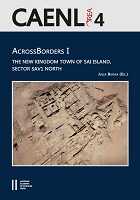AcrossBorders I
The New Kingdom Town of Sai Island, Sector SAV1 North
Contributor(s)
Budka, Julia (editor)
Collection
European Research Council (ERC)Language
EnglishAbstract
The present volume is the first in a series of monographs dedicated to the results achieved by AcrossBorders, a European Research Council Project (Austrian Academy of Sciences and Ludwig Maximilian University Munich). With its so-called Egyptian temple town and adjacent pyramid cemeteries, Sai Island is one of the prime examples for settlement policy of New Kingdom Egypt (c. 1530–1070 BC) in Upper Nubia (northern Sudan) and is the focus of this project. New fieldwork and multi-layered research conducted by the AcrossBorders project has provided fresh insights on living conditions in New Kingdom Nubia in direct comparison with Egypt.
This volume is dedicated to SAV1 North, the sector situated along the northern enclosure wall. It was excavated between 2008 and 2012 by the Sai Island Archaeological Mission and processed within the framework of AcrossBorders. The principal focus of the book is the physical remains of SAV1 North: the architecture and material culture, with emphasis on the pottery and small finds.
Datable to the mid to late 18th Dynasty, the building phase labelled as Level 3 was the heyday of sector SAV1 North – a time well-attested by several architectural remains with associated finds and pottery, which are all presented in the volume. A summary of thoughts on possible hints about the lifestyle and activities at SAV1 North preserved in the material remains completes AcrossBorders I. All in all, the evidence from SAV1 North underlines the important role Sai plays in understanding settlement patterns in New Kingdom Nubia. Der vorliegende Band ist der erste in einer Reihe von Monographien, welche die Ergebnisse des Projekts AcrossBorders vorlegt, gefördert vom Europäischen Forschungsrat (ERC) (Österreichische Akademie der Wissenschaften und Ludwig-Maximilians-Universität München). Die Insel Sai kann aufgrund einer sogenannten ägyptischen Tempelstadt und dazugehörigen Pyramidenfriedhöfen als eines der wichtigsten Beispiele für Siedlungspolitik Ägyptens im Neuen Reich (ca. 1530–1070 v. Chr.) in Obernubien (Nordsudan) gelten und steht im Mittelpunkt des Projektes. Neue Ausgrabungen und interdisziplinäre Forschungen von AcrossBorders haben frische Einblicke in die Lebensumstände in Nubien zur Zeit des Neuen Reiches im direkten Vergleich zu Ägypten erbracht. Der vorliegende Band beschäftigt sich mit dem Grabungsareal SAV1 Nord, das entlang der nördlichen Stadtmauer liegt. Es wurde zwischen 2008 und 2012 von der Sai Island Archaeological Mission ausgegraben, die detaillierte Auswertung erfolgte im Rahmen von AcrossBorders. Das Hauptaugenmerk des Buches liegt auf den materiellen Hinterlassenschaften in SAV1 Nord: der Architektur und der materiellen Kultur, letztere mit einer Betonung von Keramik und Kleinfunden. Die Blütezeit des Grabungsareals SAV1 Nord ist die sogenannte Bauschicht 3, die in die mittlere bis späte 18. Dynastie datiert werden kann und gut durch Architekturbefunde sowie zugehöriges Fundmaterial belegt ist. All diese Befunde und Funde werden im Band präsentiert. Eine Zusammenfassung mit Überlegungen zu Fragen des Lebensstils und verschiedener Aktivitäten und Funktionen in SAV1 Nord schließen AcrossBorders I ab. Insgesamt unterstreichen die hier erstmals vorgelegten Belege die wichtige Rolle der Insel Sai zum allgemeinen Verständnis von Siedlungsstrukturen in Nubien zur Zeit des Neuen Reiches.
Keywords
Nubia; architecture; material culture; EgyptDOI
10.2307/j.ctt1vjqpq9ISBN
9783700182559OCN
1135849095Publisher
Austrian Academy of Sciences PressPublication date and place
Vienna, 2017Grantor
Series
Denkschriften der Gesamtakademie, 82Classification
Archaeology


 Download
Download